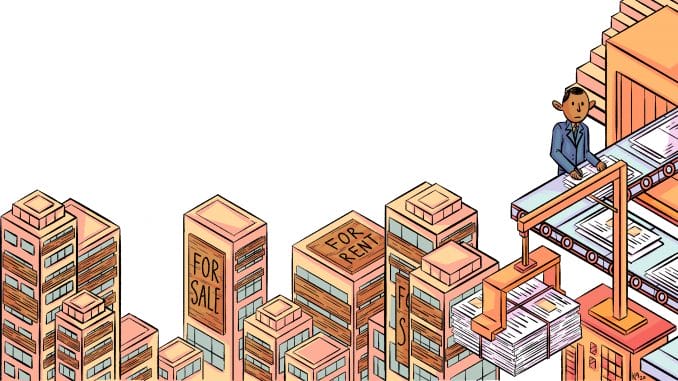
Most of us don’t remember a time when there weren’t whispers, talk and conjecture about the end of print newspapers.
It’s been inevitable since the first days of the internet that we’ve grown up with. We’ve always known that the print dailies and weeklies that appeared in newspaper boxes and at the end of driveways would quickly become relics of an era when the news business seemed a lot more promising than it does now.
Print media’s days are numbered, but they always have been. Now, there’s a more troubling threat to journalism, especially local media, and democracy: corporate ownership that cuts, sells and merges without regard for journalists or the communities that depend on their work.
College journalists are looking upon the desperate situation in newsrooms across the country like passengers on a train just a few moments away from pulling into a station that’s caught flame. News of layoffs for people just half a generation ahead of us inspires dread and sorrow.
The news industry needs owners who invest in the newsroom to bolster digital subscriptions and secure the future of journalism. But by and large, that isn’t happening.
Virginia newspapers took a hit last week in the form of Warren Buffett’s sale of BH Media, which owned 10 Virginia papers, including the Richmond Times-Dispatch, The Roanoke Times and Daily Progress. The new owner, Lee Enterprises, had managed BH Media’s 30 daily newspapers since 2018 and owned 46 dailies and more than 200 weeklies and specialty publications prior to the acquisition.
If Lee’s effect on its other papers is any indicator on what the future will bring for the publications it swept up recently, there is much to fear. At the St. Louis Post-Dispatch — which Lee bought in 2005, along with 13 other papers, for $1.46 billion — there have been steady layoffs and buyouts. By 2010, things had gotten bad. Wages were reduced, and health insurance premiums went up. That year, the company-paid pension was frozen.
“Then, there was no more fat and they went for the bone and the limbs and the non-essential organs,” Doug Moore, a reporter who worked at the Post-Dispatch for 19 years before accepting a buyout, told the Gateway Journalism Review. “Now we’re at the point where we wonder if we’re going to have people in the newsroom to produce a quality product.”
Between 2012 and 2017, Lee cut its total employment by 42% according to a review of its annual reports by Columbia Journalism Review. According to the News Guild, Lee threatened to shutter the Missoula Independent, a Montana weekly, in August 2018 if the paper’s union didn’t agree to lay off three-fourths of the staff. By September of the same year, the paper was gone.
In February 2019, it was announced that the Post-Dispatch’s editorial and news design would be moved to Lee’s design center, and nine employees would be laid off, a formula that’s become increasingly familiar to print newspapers across the country.
Things are unlikely to improve for Lee’s newspapers. In a chilling move, Alden Global Capital announced via an SEC filing that it had bought a 5.9% stake in Lee. Alden is known for cutting newsrooms to the bone, to the point that the Chicago Tribune publicly called upon billionaires with a respect for the institution to buy the paper.
The plea came after Alden bought a 32% stake in Tribune Publishing, which also owns The Virginian-Pilot, Daily Press and other papers, in November. Making matters worse for The Pilot, Tribune recently sold the paper’s building without providing concrete plans for relocation. Announcements of buyouts were made last month, and on Friday senior editor at the Virginian-Pilot Erica Smith tweeted that layoffs and buyouts had caused six journalists to leave the papers. Managing Editor Ryan Gilchrest was one of them, and Smith noted that this week will see more departures as a result of the buyouts.
Buyouts have robbed newsrooms across the country of skill, talent and valuable institutional knowledge. They’re devastating to the journalists they target, who are usually veteran staffers, to the industry, and to the communities that depend on local news. While recent college graduates aren’t typically the recipients of buyout offers, we know what the implications are for us. We will be asked to do more with fewer resources, and for a salary that presents two options: stay in the industry and be overworked on a horrible salary, or leave it behind.
Cutting from newsrooms sparks a vicious cycle: Quality suffers as journalists operate with fewer resources, and subscribers and advertisers drift away. Revenue falls, and more cuts come. This is especially poignant in an era when some of the most successful newspapers, such as The New York Times and some regional outlets, are pivoting from a focus on ad revenue to a prioritization of reader revenue, or money from subscriptions. Print ad sales are abysmal compared to what they used to be, and digital advertising doesn’t bring in much either — a Pew Research Center analysis found newspaper ad revenue fell 10% in 2015 alone. Outlets that try to fill that gap by boosting their subscriber base won’t succeed if their consumers are dissatisfied with the product because of cuts to the newsroom.
Pulling resources and staffers from a newspaper is a great strategy to pad executives’ bonuses, but it does absolutely nothing to ensure a prosperous future for the news industry or even improve a paper’s financial situation. Newspapers will never succeed under ownership that strains local journalists’ already limited capacity to cover the news with few resources. Without supportive ownership, local news may very well be doomed.


Leave a Reply